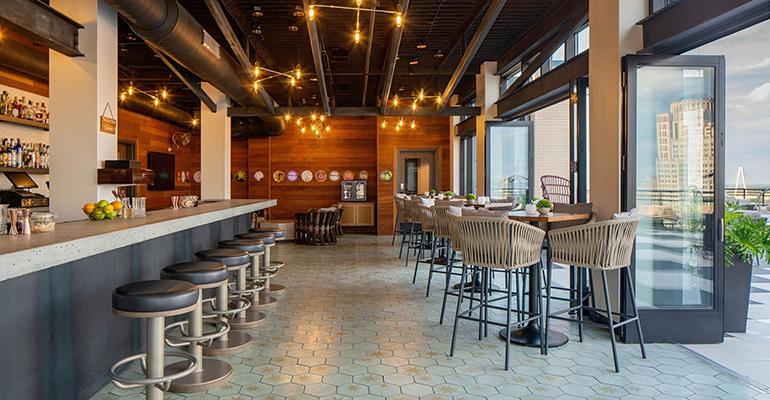As the hotel dining industry continues to feel the ongoing effects of coronavirus-related shutdowns and gradual reopenings that have significantly altered F&B operations for most of the year, it can be easy to miss the fact that 2020 is almost over. With 2021 just over a month away, Restaurant Hospitality sat down with Matt Rinehart, VP of F&B at HRI Lodging, which owns and/or manages more than 64 hotels under multiple brands across the country, for a recap of COVID-19’s impact in 2020 and how it affects the trends forecast for next year.
RH: What has been the most surprising pivot hotel F&B programs have had to make due to the pandemic, and how did your properties adapt?
Rinehart: As with most of our industry, the pandemic’s significant and steep impact to travel resulted in the closure of most of our portfolio’s core F&B programming, so we quickly moved to pantry sales and premade grab-and-go offerings in order to safely provide a small level of service to our customers. From an overall F&B perspective, re-establishing full-service venues is proving to be challenging as we have to slowly balance increasing demand driven by the needs and expectations of our guests, fiscal and business objectives, and the safety and well-being of all. The path forward to a level of occupancy at our hotels that supports viable full-service F&B varies, and in some markets, hotels may not be fully operational until mid-2021 and beyond. For us, strategically mapping each property’s ramp-up over the next six months, adding and expanding offerings and hours of operation to match demand and occupancy will be the key component of reintroducing full-service F&B to our hotels.
 Left: Matt Rinehart, VP of F&B at HRI Lodging
Left: Matt Rinehart, VP of F&B at HRI Lodging
RH: Which of the COVID-19 changes made to hotel F&B programs do you think will continue in 2021?
Rinehart: In many limited service and mid-market hotels the reliance on pantries and marketplaces for pre-packaged sales will replace evening, lunch and in some cases full-service and a la carte breakfast venues. Guests will continue to embrace and expect the convenience of take-away as long as it’s done well, and traditional room service will no longer be an expectation in full-service hotels as guest priorities shift to safety, speed and convenience.
RH: Which of the pivots currently in place for hotel F&B programs do you think are temporary?
Rinehart: As guests begin to feel an increased level of safety, we will see an expectation for the return of many aspects of traditional F&B service, such as fully set tables and communal, self-serve condiment stations and possibly even options like oyster bars and buffets.
RH: What are your predictions for hotel F&B labor in 2021?
Rinehart: In all areas of hotel operations, the pandemic and resulting economic downturn drove the need for labor efficiency and productivity to never-before seen levels. In 2021, traditional roles will be redefined by the need to be flexible and proficient in several skills. In a typical day an associate might be asked to work in multiple areas and beyond their “home” departments, and this will require a new approach to the staff selection process and how we train and prepare team members.
RH: What new F&B business opportunities will hotels seek in 2021 if the pandemic continues?
Rinehart: We will have to be very nimble in 2021 to react and adapt to market conditions. Listening to customers and adapting concepts or content, pivoting quickly with hours of operations or offerings will be key to remaining fiscally viable and consumer relevant. Until COVID-19 is completely resolved, there will be continued significant opportunity in no- or limited-contact dining, along with to-go and delivery offerings.
RH: What trends are you predicting for catered events and meeting breaks for 2021?
Rinehart: Group business and large meetings will be the last component of events and catering to return. It will be key to leverage smaller social events like creative weddings and elopements and find ways to safely celebrate these important life events with “pop-up” activations in our spaces. Hoteliers will also look to reinvent their venues to meet specific client needs for officing and virtual meetings.
RH: Pre-pandemic, what would some of your trend predictions have been for 2021?
Rinehart: I thought 2021 would continue the theme of local, housemade and authentic menus. Prior to the pandemic, I saw hotels moving away from brand-specific ideas and toward unique and highly activated hotel F&B programming with common areas designed to be neighborhood social spaces conducive to coworking, and straightforward, chef-driven restaurants with approachable and easy-to-execute menus supported by unpretentious service. While these ideas have longer-term viability, they will be affected by the likely continuation of social distancing, safety measures and guest trepidation well into 2021.
Six hotel F&B trends for 2021, according to HRI Lodging:
- Paperless menus – The ease of QR codes linking menus to smartphones has been quickly embraced by guests and will become an expectation in 2021.
- More package liquor sales – Including a bottle of wine, beer or cocktail components with to-go orders is an easy revenue enhancement. Hotels will continue to pursue this where jurisdictions allow.
- The end of traditional room service – At many full-service properties, traditional room service has been replaced by packaged deliveries to guest rooms and will continue in 2021.
- Local expectations – With fewer off-property options due to the pandemic, guests are expecting local beverages and menus using locally sourced ingredients on-property.
- Deeper dive into delivery – Hotels will look for additional ways to increase online ordering via QR menus or web-based apps for delivery to take advantage of this emerging revenue source.
- Evolving take-away menus – The dine-at-home trend continues to grow, so the industry needs to be creative and nimble to reach new markets. For example, some HRI properties are developing a holiday dinner take-away option for Thanksgiving and Christmas that includes a roasted turkey or prime rib with traditional sides, and are exploring ways to sell signature foods like pasta, sauces and pickled items.





